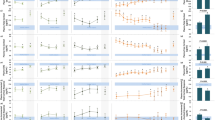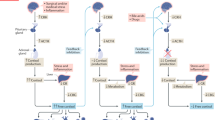Abstract
Objective
To compare the adrenocortical response to corticotropin during septic shock and after complete recovery.
Design
Prospective clinical study.
Setting
Multidisciplinary intensive care unit in a university hospital.
Patients
20 consecutive patients surviving septic shock. All patients met the American College of Chest Physicians/Society of Critical Care Medicine criteria for septic shock. In addition, the presence of high-output circulatory failure with a cardiac index >41/min per m2 was a criterion for enrollment in the study. Complete recovery from septic shock was defined as discontinuation of any supportive therapies. Severity of illness during septic shock and after recovery was graded using the Acute Physiology and Chronic Health Evaluation (APACHE) II scoring system.
Interventions
In each patient, two short corticotropin stimulation tests were done during septic shock and after recovery.
Measurements and results
Basal cortisol levels recorded during septic shock and after recovery did not differ (medians: 18.8 vs 18.9 μg/dl). However, the response to corticotropin was significantly attenuated during septic shock when compared with the response after recovery (medians: 7.7 vs 14.7 μg/dl;p=0.02). After recovery, patients' stress response was less, as indicated by a reduction in APACHE II scores (medians: 21 vs 5 points;p<0.01)
Conclusions
Adrenocortical response to corticotropin is attenuated in patients with septic shock and high-output circulatory failure compared to the response in the much less stressful condition after recovery. The attenuated adrenocortical responsiveness may be explained by effects of circulating mediators from the systemic inflammatory response.
Similar content being viewed by others
References
Schein RMH, Sprung CL, Marcial E, Napolitano L, Chernow B (1990) Plasma cortisol levels in patients with septic shock. Crit Care Med 18:259–263
Bouachour G, Tirot P, Gouello JP, Mathieu E, Vincent JF, Alquier P (1995) Adrenocortical function during septic shock. Intensive Care Med 21: 57–62
Melby JC, Egdahl RH, Spink WW (1960) Secretion and metabolism of cortisol after injection of endotoxin. J Lab Clin Med 56:50–62
Catalano RD, Parameswaran V, Ramachandran J, Trunkey DD (1984) Mechanisms of adrenocortical depression duringEscherichia coli shock. Arch Surg 119:145–150
Sibbald WJ, Short A, Cohen MP, Wilson RF (1977) Variations in adrenocortical responsiveness during severe bacterial infections. Ann Surg 186:29–33
Jurney TH, Cockrell JL, Lindberg JS, Lamiell JM, Wade CE (1987) Spectrum of serum cortisol response to ACTH in ICU patients. Chest 92:292–295
Rothwell PW, Udwadia ZF, Lawler PG (1991) Cortisol response to corticotropin and survival in septic shock. Lancet 337:582–583
Moran JL, Chapman MJ, O'Fathartaigh MS, Peisach AR, Pannall PR, Leppard P (1994) Hypocortisolaemia and adrenocortical responsiveness at onset of septic shock. Intensive Care Med 20: 489–495
Members of the American College of Chest Physicians/Society of Critical Care Medicine Consensus Conference Committee (1992) American College of Chest Physicians/Society of Critical Care Medicne Consensus Conference: Definitions for sepsis and organ failure and guidelines for the use of innovative therapies in sepsis. Crit Care Med 20:864–874
Bernard GR, Artigas A, Brigham KL, Carlet J, Falke K, Hudson L, Lamy M, LeGall JR, Morris A, Spragg R (1994) Report of the American-European consensus conference on ARDS: definitions, mechanisms, relevant outocomes and clinical trial coordination. Intensive Care Med 20:225–232
Zapol WM, Snider MT, Hill JD, Fallt RJ, Bartlett RH, Edmunds LH, Morris AH, Peirce ECI, Thomas AN, Proctor HJ, Drinker PA, Pratt PC, Bagniewski A, Miller RG (1979) Extracorporeal membrane oxygenation in severe acute respiratory failure. JAMA 242: 2193–2196
Salem M, Tanish RE, Bromberg J, Loriaux DL, Chernow B (1994) Perioperative glucocorticoid coverage. Ann Surg 219:416–425
Knaus WA, Draper EA, Wagner DP, Zimmermann JE (1985) APACHE II: A severity of disease classification system. Crit Care Med 13:818–829
May ME, Carey RM (1985) Rapid adrenocorticotropic hormone test in practice. Am J Med 79:679–684
Melby JC, Spink WW (1958) Comparative studies on adrenal cortical function and cortisol metabolism in healthy adults and in patients with shock due to infection. J Clin Invest 37:1791–1798
Bouachour G, Roy PM, Guiraud MP (1995) The repetitive short corticotropin stimulation test in patients with septic shock. Ann Intern Med 123: 962–963
Jäättelä M, Ilvesmäki V, Voutilainen R, Stenman U-H, Saksela E (1991) Tumor necrosis factor as a potent inhibitor of adrenocorticotropin-induced cortisol production and steroidogenic P450 enzyme gene expression in cultured human fetal adrenal cells. Endocrinology 128:623–629
Singh A, Bateman A, Zhu Q, Shimasaki S, Esch F, Solomon S (1988) Structure of a novel human granulocyte peptide with anit-ACTH activity. Biochem Biophys Res Commun 155: 524–529
Voerman HJ, Strack van Schijndel RJM, Groeneveld ABJ, De Boer H, Nauta JP, Thijs LG (1992) Pulsatile hormone secretion during severe sepsis: Accuracy of different blood sampling regimens. Metabolism 41:934–940
Bouachour G, Tirot P, Varache N, Gouello JP, Harry P, Alquier P (1994) Hemodynamic changes in acute adrenal insufficiency. Intensive Care Med 20: 138–141
Schneider AJ, Voerman HJ (1991) Abrupt hemodynamic improvement in late septic shock with physiological doses of glucocorticoids. Intensive Care Med 17:436–437
Briegel J, Forst H, Hellinger H, Haller M (1991) Contribution of cortisol deficiency to septic shock. Lancet 338: 507–508
Author information
Authors and Affiliations
Corresponding author
Rights and permissions
About this article
Cite this article
Briegel, J., Schelling, G., Haller, M. et al. A comparison of the adrenocortical response during septic shock and after complete recovery. Intensive Care Med 22, 894–899 (1996). https://doi.org/10.1007/BF02044113
Received:
Accepted:
Issue Date:
DOI: https://doi.org/10.1007/BF02044113




